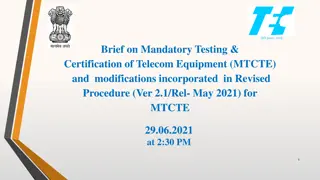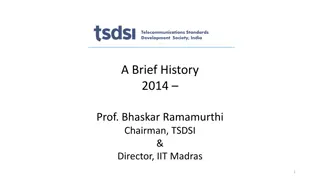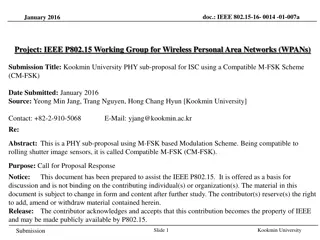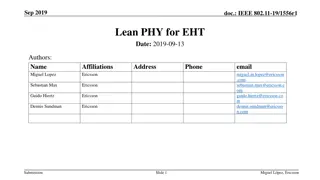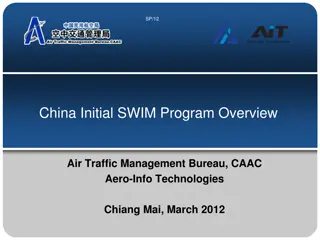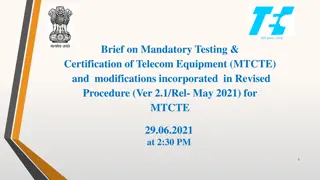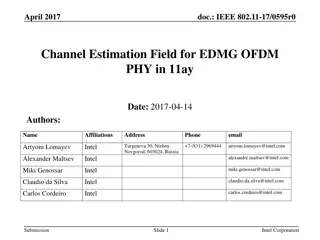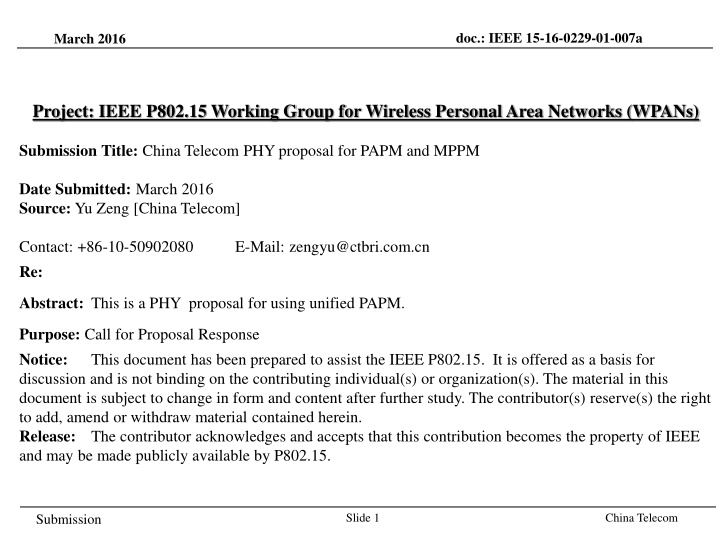
China Telecom Proposal for Unified Modulation Schemes
Explore China Telecom's PHY proposal for Pulse Amplitude and Pulse Position Modulation (PAPM) in IEEE P802.15 Working Group for Wireless Personal Area Networks (WPANs). The proposal includes M-n-PAPM schemes, modulation schemes like OOK, VPPM, and CSK, and the flexibility of defining amplitude and position based on application scenarios. Learn how different combinations of M and n in M-n-PAPM schemes offer various modulation options. Dive into detailed time waveforms and the transition between different schemes for efficient data transmission.
Download Presentation

Please find below an Image/Link to download the presentation.
The content on the website is provided AS IS for your information and personal use only. It may not be sold, licensed, or shared on other websites without obtaining consent from the author. If you encounter any issues during the download, it is possible that the publisher has removed the file from their server.
You are allowed to download the files provided on this website for personal or commercial use, subject to the condition that they are used lawfully. All files are the property of their respective owners.
The content on the website is provided AS IS for your information and personal use only. It may not be sold, licensed, or shared on other websites without obtaining consent from the author.
E N D
Presentation Transcript
doc.: IEEE 15-16-0229-01-007a March 2016 Project: IEEE P802.15 Working Group for Wireless Personal Area Networks (WPANs) Submission Title: China Telecom PHY proposal for PAPM and MPPM Date Submitted: March 2016 Source: Yu Zeng [China Telecom] Contact: +86-10-50902080 Re: E-Mail: zengyu@ctbri.com.cn Abstract: This is a PHY proposal for using unified PAPM. Purpose: Call for Proposal Response Notice: This document has been prepared to assist the IEEE P802.15. It is offered as a basis for discussion and is not binding on the contributing individual(s) or organization(s). The material in this document is subject to change in form and content after further study. The contributor(s) reserve(s) the right to add, amend or withdraw material contained herein. Release: The contributor acknowledges and accepts that this contribution becomes the property of IEEE and may be made publicly available by P802.15. Slide 1 China Telecom Submission
doc.: IEEE 15-16-0229-01-007a March 2016 Content Current 802.15.7 PHY specs Proposed Modulation Schemes M-n-PAPM Conclusion Slide 2 China Telecom Submission
doc.: IEEE 15-16-0229-01-007a March 2016 Current 802.15.7 PHY specs Modulation Schemes include OOK, VPPM and CSK Modulation schemes fixed according to different PHY Slide 3 China Telecom Submission
doc.: IEEE 15-16-0229-01-007a March 2016 Proposed Modulation Schemes Slide 4 China Telecom Submission
doc.: IEEE 15-16-0229-01-007a March 2016 PAPM(Pulse Amplitude and Pulse Position Modulation) The amplitude and position can be defined according to application scenarios. Time Waveform of 4-PPM Time Waveform of 2-4-PAPM Time Waveform of 4-PAM Slide 5 China Telecom Submission
doc.: IEEE 15-16-0229-01-007a March 2016 PAPM(Pulse Amplitude and Pulse Position Modulation) The M-n-PAPM refer to M level amplitude and n-PPM, by select different combination of M and n, the M-n-PAPM scheme can be obtained. When M = 1, the 1-n-PAPM becomes n-PPM, and when n=1, the M-1- PAPM becomes M-PAM Slide 6 China Telecom Submission
doc.: IEEE 15-16-0229-01-007a March 2016 PAPM(Pulse Amplitude and Pulse Position Modulation) 01010101 10101010 01010101 Slide 7 China Telecom Submission
doc.: IEEE 15-16-0229-01-007a March 2016 PAPM(Pulse Amplitude and Pulse Position Modulation) The proposed M-n- PAPM modulation scheme can provide a unified modulation structure for PHY I and PHY II Slide 8 China Telecom Submission
doc.: IEEE 15-16-0229-01-007a March 2016 PAPM(Pulse Amplitude and Pulse Position Modulation) 0 10 4-PPM 2-8-PAPM 2-9-PAPM -1 10 -2 10 -3 10 -4 10 -5 BER 10 -6 10 -7 10 -8 10 -9 10 -10 10 0 50 100 150 Data Rate Rb (Mb/s) SNR vs BER of M-n-PAPM and PPM BER vs Data Rate Performance M-n-PAPM Modulation Scheme when background interference changes Slide 9 China Telecom Submission
doc.: IEEE 15-16-0229-01-007a March 2016 Conclusions 1. The M-n-PAPM modulation scheme can be used to provide a unified modulation structure for OWC application, and provide a possible solution for software defined modulation module 2. Link power management can be achieved by actively select proper parameters and combinations of M and n values Slide 10 China Telecom Submission
doc.: IEEE 15-16-0229-01-007a March 2016 Appendix 1: Parameters and Geometry for Simulation Slide 11 China Telecom Submission
doc.: IEEE 15-16-0229-01-007a March 2016 Parameter Value 5 3 2 Room Dimensions (metre)(length width height) Coordination System Geometry North (reflectivity) % South West East Ceiling Floor Coordinate (0 0 0) Transmitter Location (metre) Transmitter Elevation and Azimuth (degree) Transmitter Lobe Order Receiver Location (metre) Receiver Elevation and Azimuth (degree) Receiver Area () Receiver FOV (degree) Transmitted Optical Power (Watts) Time Step (ns) Resolution (K=1 bounces) Resolution (K=2 bounces) Resolution (K=3 bounces) X (North to South)Y (East to West)Z (Floor Ceiling) 0.58 0.56 0.12 0.30 0.69 0.09 South East Floor Corner (3 0.8 2) (-90 0) 1 (2 2 0.8) (60 0) 1 70 1 0.2 30 8 4 Slide 12 China Telecom Submission





